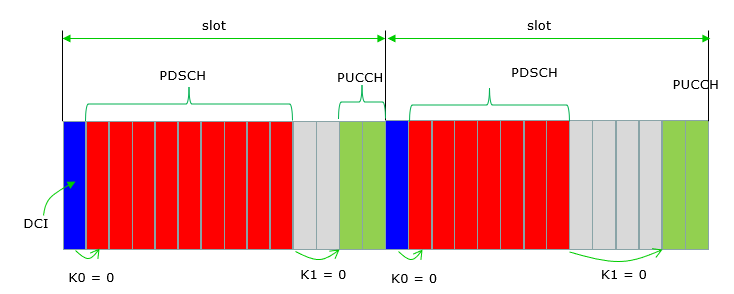|
Self Contained Slot
Simply put, self contained slot is the slot that contains everything within the single slot. What do you mean by 'everything' in this context ?
The meaning of 'everything' in this context is 'DL scheduling (DCI), DL data transmission(PDSCH) and Ack/Nack for the transmission (PUCCH)'. Therefore, self contained slot mean the slot where the scheduling, data transmission and HARQ feedback happens within the same slot as examplified below.

NOTE : The example shown above is self contained slot for PDSCH. There can be self contained slot for PUSCH as well. In case of PUSCH self contained slot, you would see a slot where UL scheduling (DCI) and PUSCH transmission would happen in the same slot. In this case, k2 should be 0.
Why self-contained slot ?
Main purpose of the purpose of a self-contained slot is to support ultra-reliable and low-latency communications (URLLC) and key benefits of self-contained slot can be listed as below ::
- Low Latency: By allowing downlink control, downlink data, uplink control, and uplink data to occur within the same slot, the time between sending information and receiving an acknowledgment (round-trip time) is greatly reduced. This is critical for applications that require immediate or near-immediate responses, such as autonomous driving, remote surgery, or real-time gaming. I think this is the biggest benefit.
- Improved Efficiency: Self-contained slots can improve the efficiency of the network by reducing the amount of time it takes to perform a communication cycle, thus freeing up resources for other users and services.
- Simplified Scheduling: The base station can schedule both downlink and uplink transmissions more easily within a single slot, simplifying the scheduling algorithm and reducing the communication overhead.
- Flexibility: This structure allows for more dynamic and flexible use of the spectrum, as different slots can be configured with different proportions of downlink and uplink according to the current demand.
What are the challenges ?
Until now (as of Dec 2023), I don't see many of the commercial device supporting this type of slots(NOTE : I have heard of some UE modem(only a few) claim to support self contained slot, but haven't heard that any network operator support this feature in the field). Does it mean that there would be too much challenges for implementing and deploying this feature ?
Yes, there are many challenges for this and some of those challenges is listed below :
- Hardware Requirements: Existing cellular infrastructure may not support the rapid switching and processing required for self-contained slots. This necessitates upgrades to base stations and the deployment of new hardware that can handle the more complex and time-sensitive nature of self-contained slot processing.
- Signal Processing Complexity: The base station must rapidly process downlink and uplink information within the same slot. This increases the complexity of signal processing and requires more advanced algorithms, which can increase the cost and power consumption of base stations.
- Network Synchronization: Self-contained slots require precise synchronization between the base station and user equipment. Any timing misalignment can disrupt the tight transmission schedule, leading to decreased efficiency and increased latency.
- Interference Management: With both uplink and downlink transmissions happening in close temporal proximity, there is an increased risk of interference, which requires advanced interference management and cancellation techniques.
- Backward Compatibility: As 5G networks are being deployed alongside existing 4G LTE infrastructure, ensuring backward compatibility can be challenging. Devices and network elements need to be designed to support both old and new protocols and slot structures.
- UE Capabilities: Not all user devices may support the new slot structures. Users with older devices may not benefit from the improvements offered by self-contained slots, leading to a fragmented experience.
- Energy Consumption: More complex processing could lead to increased energy consumption in both the network infrastructure and user devices, potentially impacting battery life and operational costs.
- Resource Allocation: Determining the optimal allocation of resources for downlink and uplink in a self-contained slot requires sophisticated algorithms, especially in dynamic network environments with varying traffic patterns and load.
Reference
|
|
